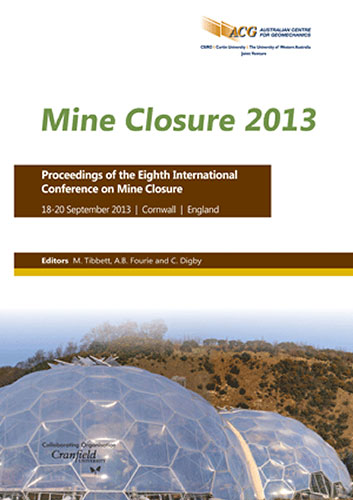Case study – integrated planning to enhance closure outcomes for the Pardoo Mine in Western Australia

|
Authors: Mackenzie, S; Beattie, T; Burne, N; Haymont, R |
DOI https://doi.org/10.36487/ACG_rep/1352_04_Mackenzie
Cite As:
Mackenzie, S, Beattie, T, Burne, N & Haymont, R 2013, 'Case study – integrated planning to enhance closure outcomes for the Pardoo Mine in Western Australia', in M Tibbett, AB Fourie & C Digby (eds), Mine Closure 2013: Proceedings of the Eighth International Seminar on Mine Closure, Australian Centre for Geomechanics, Cornwall, pp. 31-39, https://doi.org/10.36487/ACG_rep/1352_04_Mackenzie
Abstract:
The Pardoo Direct Shipping Ore Project is owned by Atlas Iron Limited and is located in the Pilbara region of Western Australia. Iron ore mining commenced in October 2008, and under the current mine plan ore reserves will be depleted during 2014. The project is significant to Atlas as its first producing mine, and the company has committed to achieving a high standard for closure planning and implementation. Closure planning commenced during the feasibility stage of the project in 2008. Detailed closure planning was initiated during 2010 and included the use of gap analysis and risk assessment to identify closure opportunities and set planning priorities. A program of targeted investigations was then undertaken to resolve gaps and risks and to enable the development of a detailed mine closure plan. Atlas will demonstrate closure performance using robust measures, including closure objectives and criteria, to facilitate lease relinquishment in a planned and timely manner. Closure objectives and criteria have been developed in consultation with stakeholders. Atlas has integrated closure planning outcomes into the operational phase of the project to realise financial and operational efficiencies. The approach that Atlas has adopted will contribute to enhanced closure outcomes for the project.
References:
ANZMEC (Australian and New Zealand Minerals and Energy Council) and MCA (Minerals Council of Australia) (2000) Strategic Framework for Mine Closure, Canberra, Australia.
DMP and EPA (2011) Department of Mines and Petroleum and Environmental Protection Authority in Western Australia. Guidelines for Preparing Mine Closure Plans, June 2011, , viewed April 2013.
Kendrick, P. and Stanley, F. (2001) Pilbara 4 (PIL4 - Roebourne synopsis), A biodiveristy audit of Western Australia’s 53 biogeographical subregions in 2002, viewed 19 January 2011, .
Mackenzie, S.I., Lacy, H.W.B. and Koontz, D. (2006) Benefits of planned versus unplanned mine closure and strategies for both, in Proceedings First International Seminar on Mine Closure (Mine Closure 2006), A.B. Fourie and M. Tibbett (eds), 13‒15 September 2006, Perth, Australia, Australian Centre for Geomechanics, Perth.
Mackenzie, S.I., Mitchell, I. and McGuire, C. (2008), Progressive rehabilitation and closure planning using GIS-based software at the Mungari project, Western Australia, in Proceedings of the Goldfields Environmental Management Group Conference, Kalgoorlie, Western Australia.
© Copyright 2025, Australian Centre for Geomechanics (ACG), The University of Western Australia. All rights reserved.
View copyright/legal information
Please direct any queries or error reports to repository-acg@uwa.edu.au
View copyright/legal information
Please direct any queries or error reports to repository-acg@uwa.edu.au